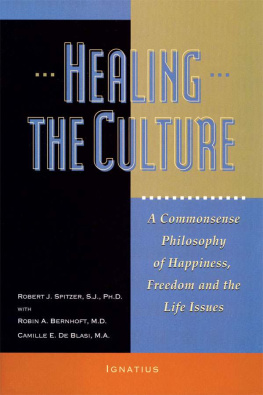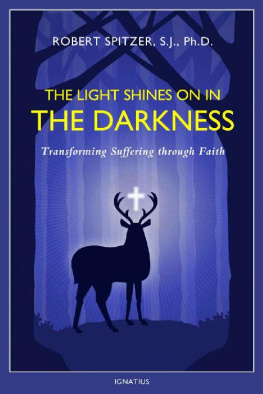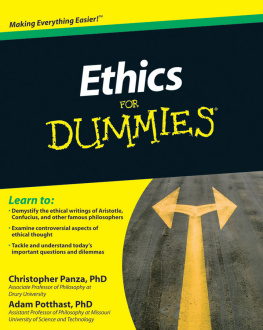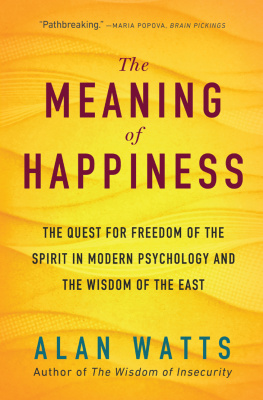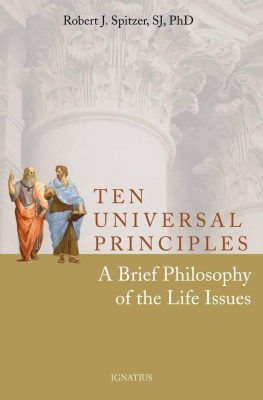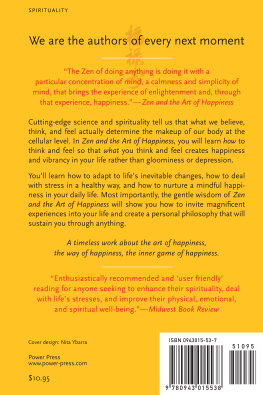HEALING THE CULTURE
HEALING THE CULTURE
A Commonsense Philosophy of Happiness, Freedom, and the Life Issues
by
Robert J. Spitzer, S.J., Ph.D.
with
Robin A. Bernhoft, M.D. and Camille E. De Blasi, M.A.
IGNATIUS PRESS SAN FRANCISCO
Cover design by Riz Boncan Marsella
2000 Ignatius Press, San Francisco
All rights reserved
ISBN 0-89870-786-2
Library of Congress control number 99-68612
Printed in the United States of America
To my mother,
whose inspiration and prayers underlie
every principle in this volume
Contents
PART ONE
DEFINING PERSON AND HAPPINESS
Chapter One: Defining the Human Person
Chapter Two: Defining Happiness
Chapter Three: Moving Through the Levels of Happiness
PART TWO: THE TEN CATEGORIES
OF CULTURAL DISCOURSE
Chapter Four: Happiness, Success, Quality of Life, and Love
Chapter Five: Suffering Well
Chapter Six: Ethics and Freedom
Chapter Seven: Person, Rights, and the Common Good
Chapter Eight: Summary of the Ten Categories of Cultural Discourse
PART THREE: THE LIFE ISSUES:
ABORTION AND EUTHANASIA
Chapter Nine: Abortion
Chapter Ten: Euthanasia
Acknowledgments
My most profound gratitude for the inspiration and help of Camille E. De Blasi, M.A., who spent countless hours advising, researching, editing, diagramming, and typing two full drafts of this volume. I am most particularly thankful for her inspired leadership in starting and maintaining the Life Principles project. Without her creativity, enthusiasm, energy, and self-sacrifice in producing everything from the videotapes to the publicity pamphlets, this project would simply not have been possible.
My sincerest and profound gratitude to Robin A. Bernhoft, M.D., for his authorship of much of Chapter Ten. I am particularly grateful for the hours he spent coauthoring, encouraging, and editing the first draft of this volume. His medical knowledge, humanistic and theological insight, and incisive writing style were essential to the initiation and maintenance of this project.
I would also like to express my sincere gratitude to Human Life of Washington, which supported this project financially from its inception to the present. In particular I would like to thank Kenneth VanDerhoef for his continuous spiritual, moral, and financial support; Eileen and Jef Geller for their encouragement, prayers, and advice; my sister, Lynne Malone, who did the technical production for the Life Principles video series; and Pete and Janet Flatley, Sarah Spangler, and all others who offered their encouragement and support.
Foreword
In addition to its original purpose of providing an assessment and solution for many of our cultural problems, this book is also meant to be a resource for the Life Principles project. This project is devoted to explaining the underlying philosophy of the pro-life movement to a diverse audience.
Several years ago, when working on both cultural philosophy and the Life Principles projects independently of one another, I discovered many areas of intersection. Later I decided to combine the two projects into what has now emerged as the current draft of this book.
With respect to its use as a cultural philosophy, I have found the Life Principles to be useful in businesses, nonprofit organizations, law firms, university and high school environments, and even nursing homes and hospitals. With respect to its use as a pro-life philosophy, I have found that its uniquely rational and commonly accessible approach has had a powerful and overwhelmingly positive effect on pro-life education for the national public.
This program, with its two objectives, is more than just a written curriculum. I have developed, in conjunction with the Center for Life Principles, a video series that may be used in community organizations, church groups, university environments, and even high schools. The Center for Life Principles will assist interested people in bringing this video series to any interested group. In addition, the Center for Life Principles has developed a high school curriculum, a retreat program, a speakers bureau, and is beginning work on a curriculum for nursing homes and hospitals.
Readers who are interested in facilitating this program in any of the above-mentioned environments or becoming members of the Life Principles team should use the information on page 347 below.
Introduction
I. An Invisible Agent of Cultural Decline
There are many positive signs in the world today, such as economic prosperity in many regions; international cooperation as markets become more open; heightened awareness of cultural diversity; increased access to education, information, transportation, communication, and technology; and improvements in health and medicine. Nevertheless, many people within our society are dismayed by what may appear to be a cultural decline. Individuals encounter numerous ethical and personal difficulties within the workplace, public officials lack the respect they once cherished, ethical relativism seems to dominate much of our thinking, depression is on the rise, divorce and family breakups are increasing, and cynicism about life and its prospects is a national epidemic. Even adolescents seem to be overcome by a malaise about life. The nation has been greatly troubled by the growing episodes of schoolchildren who shoot their teachers and classmates. One gets the impression that our culture is in desperate need of revitalization and even healing.
Although the combined efforts of government and social organizations have developed a myriad of programs to combat the above-mentioned problems, these programs tend to act more like bandages than remedies. It seems there is a deeper cause of these problems. Perhaps there is something deep within our cultural consciousness that, like a rapidly mutating virus, continues to adapt itself to all superficial cures and exert itself anew.
If we are to move beyond the more insidious effects of this agent, we must begin to understand it. We must learn how to see it for what it really is. Rather than content ourselves with cataloguing its every effect, we must get to the nature of the beast. I would submit that the beasts identity is reflected in the minimalistic way we see ourselves. More precisely, it is a radically incomplete cultural attitude about what it means to be a human person.
It is hard to imagine that one little incomplete attitude like the one suggested above can produce so much malaise, depression, violence, confusion, and even chaos. Though it is not the sole reason for these problems, I do believe that it lies at the root of most of them. We might consider the analogy of a person from the Middle Ages coming into the twentieth century to discover that the plague that wiped out a third of Europes population was caused by a completely invisible agent. I would like this book to be as helpful for our culture as a powerful microscope would have been for the medieval scientist. I hope that this book will serve as a sort of philosophical microscope that uses very fundamental ideas to probe the meanings, motives, values, and ideals of individuals and the cultures in which they live.
II. Materialism and the Loss of Intangibles
Materialism is sometimes associated with people who invest their lifes meaning in the products of a department store or real-estate agency. Though this reflects the meaning of ethical materialism, it only partially indicates the meaning of metaphysical materialism. Metaphysics seeks to understand the ground, indeed, the ultimate ground of reality. Hence, metaphysical materialism tends to reduce reality to matter. Frequently, the term matter is interpreted not in light of late twentieth-century physics (for example, quantum theory, relativity theory, big bang cosmology) but rather in terms of what is tangible, clearly perceived, and clearly understood (for example, colors, solids, locomotion). This kind of materialism tends to view reality as building blocks that are clearly perceived by individuals and even clearly within their control. Unfortunately, as contemporary physicists would hasten to note, it does not describe physical reality accurately, and it certainly does not describe nonphysical or spiritual reality adequately. Nevertheless, it is a mind-set that is readily accepted by our culture because it is clear and simple and gives the illusion of control.
Next page
